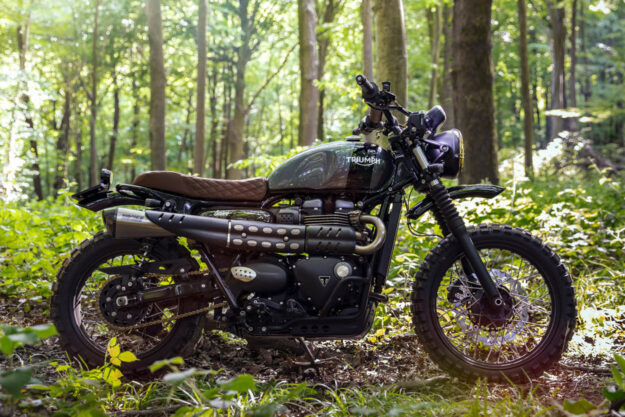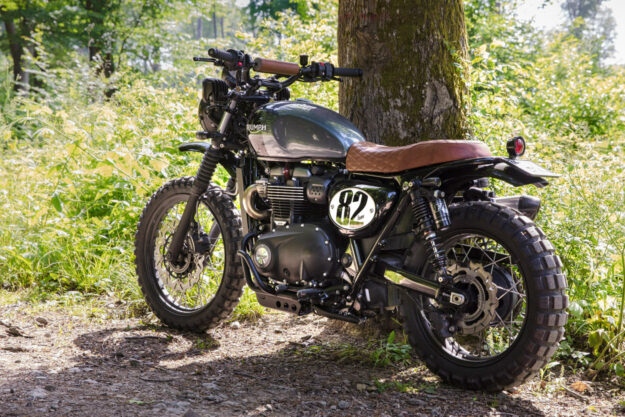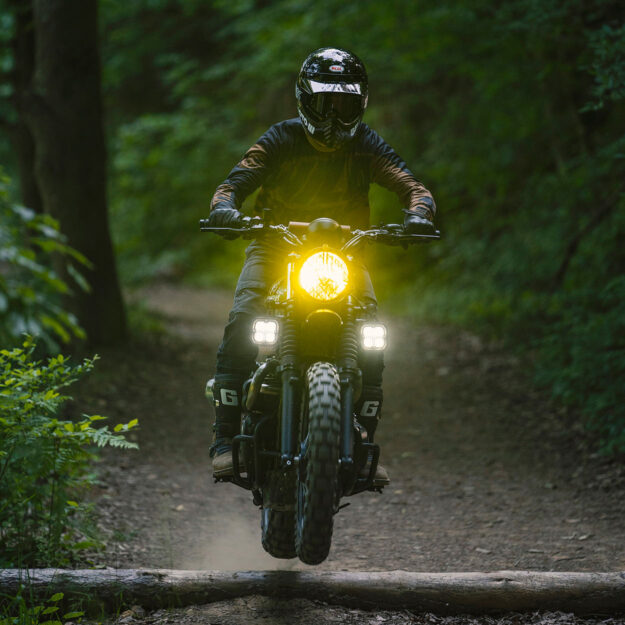Speed Read, September 5, 2021

This week we’ve got a pair of very different classic Hondas: a CB550 rebuilt in lockdown, and a feisty lil’ NSR50 pocket rocket. Plus a new BMW concept aimed at Gen Z, and a limited production run of custom Ducatis from NCT in Austria. Honestly, we’d take ’em all.

Honda NSR50 at Four Stroke Barn One of the biggest collector scenes in our world focuses on Honda mini bikes: from limited edition Monkeys to miniature miracles like the NSR50. In Europe, the Dutch company Four Stroke Barn is a major player, with dozens of obscure tiddlers on its books—most imported directly from Japan, with all the vital paperwork and approvals.

This NSR50 caught our eye, with 21,000 kilometers on the clock and a sticker price of €2,851 (US$3,400). You don’t often see these models outside of Japan, because they were only produced for a short period in 2004, but they occasionally pop up in race series.
The engine is a revvy water-cooled two-stroke pumping out 7.2 hp, but on a bike weighing around 160 pounds, that’s enough for a little fun. Especially with a six-speed close-ratio ‘box and a top speed of around 60 mph, which was higher than most contemporaries.

Despite not being street legal in the US at the time of sale, word on the street is that it’s possible to get one registered these days, if you know your way around the legislation—and can install lights, turn signals and mirrors.
You probably wouldn’t want to use this machine for a trip down Route 66, but for getting the groceries or popping out to a local café, it’s probably more fun than a barrel of monkeys.

Ducati Evo Racer by NCT Five years ago, one of the most popular bikes on EXIF was a stunning Ducati 848 café racer by the Austrian shop NCT. David Widmann and his crew have now launched a run of 70 limited production models, with 30 using the 848 as a donor bike, 30 using the 1098, and ten using the 1198.

The biggest visual differences compared to the stock Ducatis come from the new bodywork and seat. They not only give the Ducatis a ‘retro racer’ feel, but also knock around 20 kilos (45 pounds) off the weight.
The material is carbon fiber and it’s taken engineer Michael Kölz over a year to develop and productionize, along with a new rear subframe that now hides a compact li-ion battery.

The new suspension is Öhlins all round, with the forks held in custom triple clamps that raise the clip-ons slightly higher than stock for a more comfortable riding position. The lighting is new all-round too, with a powerful LED headlamp up front and bar-end blinkers, and the exhaust has been upgraded to an Akrapovič system.
There are far too many other mods to cover off here, but our report on the original Evo machine gives you a guide.

The color possibilities are almost unlimited, but the standard colors are British Racing Green, Miami Blue, Pure White, Agate Grey or Black.
Pricing starts at €25,848 (US$30,700) for an 848, running up to €48,780 (US$58,000) for a fully-kitted out 170 hp, 155 kg 1198 with an even higher spec. This includes the cost of donor bikes, which are all pristine used models with very low kilometers and no track history. Tempting … [NCT Motorcycles]

Honda CB550 by Mark Colasante It’s hard to find any positives in the coronavirus situation, but if there’s a tiny mercy, it’s that lockdowns have inspired many folks to head to the garage or home workshop and spin the spanners.
One such home builder is Mark Colasante, an Ohio-based CEO who runs an online learning company. Mark has been riding since the age of ten, when his father built him a mini bike with a Briggs & Stratton lawn mower engine—and he’s finally had an incentive to get stuck into his own build project.

In 2013 Mark bought this 1975 CB550 K1, and figured he’d turn it into a cafe racer. His workshop is home to a compressor, blasting cabinets, a CNC machine and a paint/Cerakote booth; it was just a question of finding the time.
To start the build, Mark stripped the bike down and blasted off decades of crud. He rebuilt the engine back to factory spec, and repaired any obvious damage to the frame before getting it powder coated.

The mods are simple, with a focus on a classic rather than aggressive look. None of it is rocket science, but all of it is beautifully done and well chosen, from the simple rear frame loop and curvy seat and tail unit to the CNC-cut gauge mount.
Much of the work is hidden, such as the complete new electrical system—using a m.unit Blue control box, speedo, switchgear and blinkers from Motogadget.

The vapor-blasted engine is finished in Cerakote grey, and compression testing records a smidge under 170 psi. The rebuilt forks are hiding Race Tech springs and emulator valves, and the CB now rides on D.I.D. rims finished off with spokes from Buchanan’s.
Mark’s called his CB550 ‘Project Clean Slate,’ and that’s a great name for it. Proof that you don’t always have to reinvent the wheel—and good things take time. [Mark Colasante instagram | Via]

BMW Motorrad Concept CE 02 BMW has just released an electric concept that could sit underneath the radical CE 04 maxi scooter in its range. BMW describes the concept as ‘neither a classic motorcycle nor a scooter’ and it’s aimed at younger, urban riders who would not normally buy a motorcycle.

The CE 02 has got a predictably sniffy response from some quarters—mostly those occupied by elder members of the motorcycle press—but we love it. Top speed is 90kph, range is around 90 km, and the weight is a user-friendly 120 kg (198 pounds).
BMW also references the idea of a “skateboard on two wheels” and the seat certainly brings that analogy to life. The 15-inch disc wheels are pothole-friendly, and will be appreciated by anyone who has encountered a badly-repaired road at high speed on a Vespa with 11-inch rims.

The styling is just as futuristic as the CE 04 on sale now, which was suprisingly little changed from its own ‘Definition’ concept of a few years earlier. This suggests that BMW may put the CE 02 into production without drifting too far away from the design we’re looking at here.
We suspect this bike could be a hit with Gen Z in the cities of mainland Europe. It’s all over the tech and lifestyle websites for starters, which is rare for a moto concept. The kicker, as always, will be the pricing. Anything substantially more than Vespa money will turn the CE 02 into a toy for the rich. [More]
Continue reading...

This week we’ve got a pair of very different classic Hondas: a CB550 rebuilt in lockdown, and a feisty lil’ NSR50 pocket rocket. Plus a new BMW concept aimed at Gen Z, and a limited production run of custom Ducatis from NCT in Austria. Honestly, we’d take ’em all.

Honda NSR50 at Four Stroke Barn One of the biggest collector scenes in our world focuses on Honda mini bikes: from limited edition Monkeys to miniature miracles like the NSR50. In Europe, the Dutch company Four Stroke Barn is a major player, with dozens of obscure tiddlers on its books—most imported directly from Japan, with all the vital paperwork and approvals.

This NSR50 caught our eye, with 21,000 kilometers on the clock and a sticker price of €2,851 (US$3,400). You don’t often see these models outside of Japan, because they were only produced for a short period in 2004, but they occasionally pop up in race series.
The engine is a revvy water-cooled two-stroke pumping out 7.2 hp, but on a bike weighing around 160 pounds, that’s enough for a little fun. Especially with a six-speed close-ratio ‘box and a top speed of around 60 mph, which was higher than most contemporaries.

Despite not being street legal in the US at the time of sale, word on the street is that it’s possible to get one registered these days, if you know your way around the legislation—and can install lights, turn signals and mirrors.
You probably wouldn’t want to use this machine for a trip down Route 66, but for getting the groceries or popping out to a local café, it’s probably more fun than a barrel of monkeys.

Ducati Evo Racer by NCT Five years ago, one of the most popular bikes on EXIF was a stunning Ducati 848 café racer by the Austrian shop NCT. David Widmann and his crew have now launched a run of 70 limited production models, with 30 using the 848 as a donor bike, 30 using the 1098, and ten using the 1198.

The biggest visual differences compared to the stock Ducatis come from the new bodywork and seat. They not only give the Ducatis a ‘retro racer’ feel, but also knock around 20 kilos (45 pounds) off the weight.
The material is carbon fiber and it’s taken engineer Michael Kölz over a year to develop and productionize, along with a new rear subframe that now hides a compact li-ion battery.

The new suspension is Öhlins all round, with the forks held in custom triple clamps that raise the clip-ons slightly higher than stock for a more comfortable riding position. The lighting is new all-round too, with a powerful LED headlamp up front and bar-end blinkers, and the exhaust has been upgraded to an Akrapovič system.
There are far too many other mods to cover off here, but our report on the original Evo machine gives you a guide.

The color possibilities are almost unlimited, but the standard colors are British Racing Green, Miami Blue, Pure White, Agate Grey or Black.
Pricing starts at €25,848 (US$30,700) for an 848, running up to €48,780 (US$58,000) for a fully-kitted out 170 hp, 155 kg 1198 with an even higher spec. This includes the cost of donor bikes, which are all pristine used models with very low kilometers and no track history. Tempting … [NCT Motorcycles]

Honda CB550 by Mark Colasante It’s hard to find any positives in the coronavirus situation, but if there’s a tiny mercy, it’s that lockdowns have inspired many folks to head to the garage or home workshop and spin the spanners.
One such home builder is Mark Colasante, an Ohio-based CEO who runs an online learning company. Mark has been riding since the age of ten, when his father built him a mini bike with a Briggs & Stratton lawn mower engine—and he’s finally had an incentive to get stuck into his own build project.

In 2013 Mark bought this 1975 CB550 K1, and figured he’d turn it into a cafe racer. His workshop is home to a compressor, blasting cabinets, a CNC machine and a paint/Cerakote booth; it was just a question of finding the time.
To start the build, Mark stripped the bike down and blasted off decades of crud. He rebuilt the engine back to factory spec, and repaired any obvious damage to the frame before getting it powder coated.

The mods are simple, with a focus on a classic rather than aggressive look. None of it is rocket science, but all of it is beautifully done and well chosen, from the simple rear frame loop and curvy seat and tail unit to the CNC-cut gauge mount.
Much of the work is hidden, such as the complete new electrical system—using a m.unit Blue control box, speedo, switchgear and blinkers from Motogadget.

The vapor-blasted engine is finished in Cerakote grey, and compression testing records a smidge under 170 psi. The rebuilt forks are hiding Race Tech springs and emulator valves, and the CB now rides on D.I.D. rims finished off with spokes from Buchanan’s.
Mark’s called his CB550 ‘Project Clean Slate,’ and that’s a great name for it. Proof that you don’t always have to reinvent the wheel—and good things take time. [Mark Colasante instagram | Via]

BMW Motorrad Concept CE 02 BMW has just released an electric concept that could sit underneath the radical CE 04 maxi scooter in its range. BMW describes the concept as ‘neither a classic motorcycle nor a scooter’ and it’s aimed at younger, urban riders who would not normally buy a motorcycle.

The CE 02 has got a predictably sniffy response from some quarters—mostly those occupied by elder members of the motorcycle press—but we love it. Top speed is 90kph, range is around 90 km, and the weight is a user-friendly 120 kg (198 pounds).
BMW also references the idea of a “skateboard on two wheels” and the seat certainly brings that analogy to life. The 15-inch disc wheels are pothole-friendly, and will be appreciated by anyone who has encountered a badly-repaired road at high speed on a Vespa with 11-inch rims.

The styling is just as futuristic as the CE 04 on sale now, which was suprisingly little changed from its own ‘Definition’ concept of a few years earlier. This suggests that BMW may put the CE 02 into production without drifting too far away from the design we’re looking at here.
We suspect this bike could be a hit with Gen Z in the cities of mainland Europe. It’s all over the tech and lifestyle websites for starters, which is rare for a moto concept. The kicker, as always, will be the pricing. Anything substantially more than Vespa money will turn the CE 02 into a toy for the rich. [More]
Continue reading...



















































































































